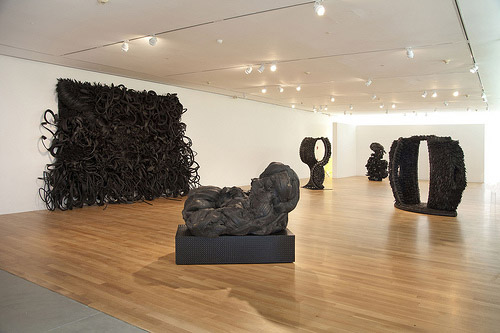The DeCordova Gets Tired
Forgive the tired pun of the title. When it comes to sculptor Chakaia Booker’s art, it’s hard to avoid. Rubber Soul. Retread Retro. Rubber Made. Rubber Maid. Where the Rubber Meets the Museum, etc. Suffice it to say they’ve all been used. That’s because Chakaia Booker makes fantastic sculptures out of old tires. I first […]

Installation View
Forgive the tired pun of the title. When it comes to sculptor Chakaia Booker’s art, it’s hard to avoid. Rubber Soul. Retread Retro. Rubber Made. Rubber Maid. Where the Rubber Meets the Museum, etc. Suffice it to say they’ve all been used. That’s because Chakaia Booker makes fantastic sculptures out of old tires.
I first saw Chakaia Booker’s sculpture at the 2000 Whitney Biennial, a jungle of sliced black rubber erupting from a wall and ironically titled “It’s So Hard to Be Green.” I took the title to be a triple reference to the difficulty of representing green foliage with black rubber, to the green practice of recycling old tires into new art, and to an African-American artist’s twist on Kermit the Frog’s lament about skin color.
“It’s So Hard to be Green” is now one of the works featured in Chakaia Booker: In and Out, a major retrospective of Booker’s indoor and outdoor sculpture at the DeCordova Sculpture Park & Museum in Lincoln, Massachusetts (through August 19) being billed as “the largest and most comprehensive museum exhibition of this African-American artist’s work to date.”
Rubber is a marvelously rich medium for Booker. Not only do the wide range of old tire hues speak to the spectrum of African-American skin colors, but the tread patterns can reference tribal scarification, the cultivation and manufacture of rubber conjure both colonialism and the industrialism that brought African-Americans north, and tires themselves are emblematic of America, a mobile, throw-away society.
Chakaia Booker was born in Newark, New Jersey in 1953 and now lives and works in both New Your City and Allentown, Pennsylvania. She seems to have come to art through remaking old clothes to fit her and, subsequently, through making wearable art. She started working in rubber in the 1990s when, in search of cheap and plentiful materials, she started salvaging tires from burnt-out and abandoned cars.
Booker manages to assemble her chosen medium into a full range of three-dimensional objects, the 30 pieces featured in the DeCordova show including monumental outdoor sculpture, wall reliefs, floor sculpture, and pedestal pieces. Most are abstract configurations of sliced, chopped, curled, twisted, dangling black rubber, but Booker’s work, used freely and over armatures, evokes everything from vegetated landscape to architecture, geometry, and biology. Most are sensuous and appealing. Some are just awkward and unappealing. But, of course, there are always those overlays of social, sexual, racial, and class meanings inherent in black rubber.
On the one hand, Chakaia Booker’s discovery of the inexhaustible possibilities of black rubber is a stroke of brilliance, making her the Louise Nevelson of old tires, the High Priestess of the Recycled. On the other, you almost have to feel sorry for an artist who becomes so successful at one thing that she can’t try something else. That’s why its good to see that Booker’s most recent 2010 work in the exhibition are photogravure images of herself as a warrior scavenging dumps for tires and a mutli-media mural that hangs in a DeCordova stairwell.
Louise Nevelson’s found object constructions are most desirable in monochrome black, but she also executed them in white and green. Booker might want think about painting more of her rubber works, as she did in 1994 with the red rubber “Dorothy’s Shoes.” I also have to wonder how they would be received were they executed in wood, steel, plastic, or stone.
[DeCordova Sculpture Park & Museum, 51 Sandy Pond Rd., Lincoln MA, 781-259-8355.]
Edgar Allen Beem
Take a look at art in New England with Edgar Allen Beem. He’s been art critic for the Portland Independent, art critic and feature writer for Maine Times, and now is a freelance writer for Yankee, Down East, Boston Globe Magazine, The Forecaster, and Photo District News. He’s the author of Maine Art Now (1990) and Maine: The Spirit of America (2000).
More by Edgar Allen Beem

